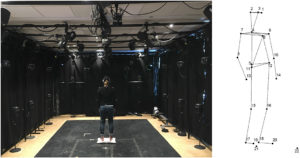After several years of hard work, we are very happy to announce a new publication coming out of the MICRO project that I am leading: Headphones or Speakers? An Exploratory Study of Their Effects on Spontaneous Body Movement to Rhythmic Music (Frontiers Psychology).

This is the first journal article of my PhD student Agata Zelechowska, and it reports on a standstill study conducted a couple of years ago. It is slightly different than the paradigm we have used for the Championships of Standstill. While the latter is based on single markers on the head of multiple people, Agata’s experiment was conducted with full-body motion capture of individuals.
The most exciting thing about this new study, is that we have investigated whether there are any differences in people’s micromotion when they listen through either headphones or speakers. Is there a difference? Yes, it is! People move (a little) more when listening through headphones.
Want to know more? The article is Open Access, so you can read the whole thing here. The short summary is here:
Previous studies have shown that music may lead to spontaneous body movement, even when people try to stand still. But are spontaneous movement responses to music similar if the stimuli are presented using headphones or speakers? This article presents results from an exploratory study in which 35 participants listened to rhythmic stimuli while standing in a neutral position. The six different stimuli were 45 s each and ranged from a simple pulse to excerpts from electronic dance music (EDM). Each participant listened to all the stimuli using both headphones and speakers. An optical motion capture system was used to calculate their quantity of motion, and a set of questionnaires collected data about music preferences, listening habits, and the experimental sessions. The results show that the participants on average moved more when listening through headphones. The headphones condition was also reported as being more tiresome by the participants. Correlations between participants’ demographics, listening habits, and self-reported body motion were observed in both listening conditions. We conclude that the playback method impacts the level of body motion observed when people are listening to music. This should be taken into account when designing embodied music cognition studies.